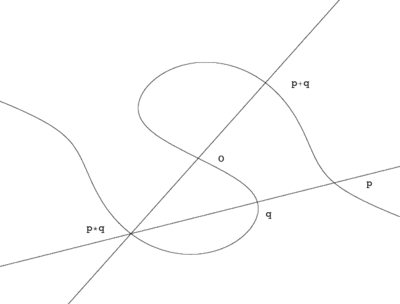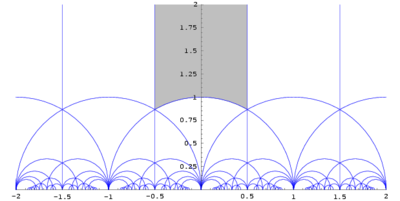Elliptic curve
An elliptic curve over a field is a one dimensional Abelian variety over . Alternatively it is a smooth algebraic curve of genus one together with marked point.
Curves of genus 1 as smooth plane cubics
If is a homogenous degree 3 (also called "cubic") polynomial in three variables, such that at no point all the three derivatives of f are simultaneously zero, then the Null set is a smooth curve of genus 1. Smoothness follows from the condition on derivatives, and the genus can be computed in various ways; e.g.:
- Let be the class of line in the Picard group , then is rationally equivalent to . Then by the adjunction formula we have .
- By the genus-degree formula for plane curves we see that
- If we choose a point and a line such that , we may project to by sending a point to the intersection point (if take the line instead of the line ). This is a double cover of a line with four ramification points. Hence by the Riemann-Hurwitz formula
On the other hand, if is a smooth algebraic curve of genus 1, and are points on , then by the Riemann-Roch formula we have . Choosing a basis to the three dimensional vector space such that is algebraic and , the map given by is an embedding.
The group operation on a pointed smooth plane cubic
Let be as above, and point on . If and are two points on we set where if we take the line instead, and the intersection is to be understood with multiplicities. The addition on the elliptic curve is defined as . Both the commutativity and the existence of inverse follow from the definition. The proof of the associativity of this operation is more delicate.
Weierstrass forms
Suppose that the cubic curve admits a flex defined over K, that is, a line which is tri-tangent to at a point : this will happen, for example, if the field is algebraically closed). In this case there is a change of coordinates on the projective plane which takes the line to the line and the point to the point : we may thus assume that the only terms in the cubic polynomial which include , are . The equation can then be put in generalised Weierstrass form
If the characteristic of is not 2 or 3 then by another change of coordinates, the cubic polynomial can be changed to the form
In this case the discriminant of the cubic polynomial on the right hand side of the equation is given by , and is non-zero because the curve is non-singular. The invariant of the curve is defined to be . Two elliptic curves are isomorphic over an algebraically closed field if and only if they have the same invariant.
Elliptic curves over the complex numbers
One dimensional complex tori and lattices in the complex numbers
An elliptic curve over the complex numbers is a Riemann surface of genus 1, or a two dimensional torus over the real numbers. The universal cover of this torus, as a complex manifold, is the complex line . Hence the elliptic curve is isomorphic to a quotient of the complex numbers by some lattice; moreover two elliptic curves are isomorphic if and only the two corresponding lattices are isomorphic. Hence the moduli of elliptic curves over the complex numbers is identified with the moduli of lattices in up to homothety. For each homothety class there is a lattice such that one of the points of the lattice is 1, and the other is some point in the upper half plane .
Hence the moduli of lattices in is the quotient , where a group element
acts on the upper half plane via the mobius transformation . The standard fundamental domain for this action is the set: .
Modular forms
For the main article see Modular forms Modular forms are functions on the upper half plane, such that for any we have for some which is called the "weight" of the form.
Theta functions
For the main article see Theta function
Weierstrass's function
Let be a lattice. The Weirstrass -function is the absolutely convergent series where the sum is taken over all nonzero lattice points. It is an elliptic function having poles of order two at each lattice point.
Application: elliptic integrals
Elliptic curves over number fields
Let K be an algebraic number field, a finite extension of Q, and E an elliptic curve defined over K. Then E(K), the points of E with coordinates in K, is an abelian group. The structure of this group is determined by the Mordell-Weil theorem, which states that E(K) is finitely generated. By the fundamental theorem of finitely generated abelian groups we have
where the torsion-free part has finite rank r, and the torsion group T is finite.
It is not known whether the rank of an elliptic curve over Q is bounded. The elliptic curve
has rank at least 28, due to Noam Elkies [1].
The torsion group of a curve over Q is determined by Mazur's theorem; over a general number field K a result of Merel[2] shows that the torsion group is bounded in terms of the degree of K.
The rank of an elliptic curve over a number field is related to the L-function of the curve by the Birch-Swinnerton-Dyer conjectures.
Mordell-Weil theorem
The proof of the Mordell-Weil theorem combines two main parts. The "weak Mordell-Weil theorem" states that the quotient is finite: this is combined with an argument involving the height function.
The theorem also applies to an abelian variety A of higher dimension over a number field. The Lang-Néron theorem implies that A(K) is finitely generated when K is finitely generated over its prime field.
Mazur's theorem
Mazur's theorem[3] shows that the torsion subgroup of an elliptic curve over Q must be one of the following
Each of these torsion structures is parametrizable.[4]
Elliptic curves over finite fields
Application:cryptography
Elliptic curves over local fields
References
- ↑ N. Elkies, Posting to NMBRTHRY list, May 2006
- ↑ Loïc Merel (1996). "Bornes pour la torsion des courbes elliptiques sur les corps de nombres". Invent. Math. 124: 437-449.
- ↑ Barry C. Mazur (1978). "Rational isogenies of prime degree". Invent. Math. 44: 129-162.
- ↑ D.S. Kubert (1976). "Universal bounds on the torsion of elliptic curves". J. London Maths Soc. 33: 193-227.








![{\displaystyle \#K_{E}=(K_{\mathbb {P} ^{2}}+[E])[E]=(-3H+3H)3H=0}](https://wikimedia.org/api/rest_v1/media/math/render/svg/de60603bf64f299b1aea40d5dfb2a165aeb073aa)























































